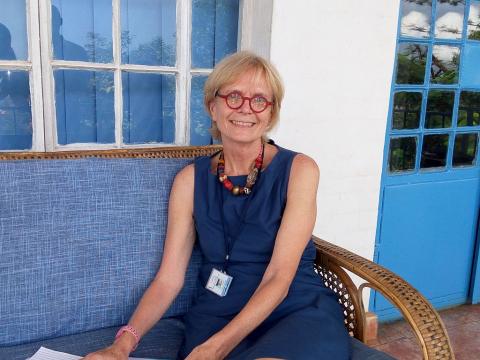By Kemo Cham
The World Health Organisation has ranked Sierra Leone among countries with the highest burden of cases of tuberculosis - or TB - in the world.
In a new report published last week, Sierra Leone, alongside its next door neighbour Liberia, was placed among the top 10 countries with the highest number of TB cases per capita, with an official calling for redoubling of efforts by the government and its partners to tackle the epidemic.
Sierra Leone recorded an estimated 20,000 new TB cases and 3, 300 TB-related deaths in 2015, according to the 2016 ‘Global Tuberculosis Report’ which also stresses the urgent need for countries to move rapidly in their prevention, detection and treatment efforts if the world is to meet the global target of ending the epidemic.
In the report, which also calls for the need for bold political commitment, WHO warns that funding shortfall risks holding back efforts to end the epidemic, especially in poor countries like Sierra Leone.
TB is an infectious bacterial disease caused by Mycobacterium tuberculosis. It most commonly affects the lungs and is transmitted from person to person via droplets from the throat and lungs of people with the active respiratory disease.
It is a top infectious killer disease worldwide.
Over 95 percent of TB deaths occur in low- and middle-income countries, according to WHO, which adds that the Africa region has the highest rate of cases.
This new report also shows that global TB burden was underestimated in previous data. It shows that in 2015 there were an estimated 10.4 million new cases worldwide, above the 9 million previously stated. Also, an estimated 1.8 million deaths were recorded in the same year, compared to the 1.5 million initially stated.
Although global TB deaths fell by 22 percent between 2000 and 2015, the disease was one of the top 10 causes of deaths worldwide in 2015, responsible for more deaths than HIV and malaria, the report further notes.
On a positive note, efforts to respond to TB saved more than 3 million lives in the period, it adds.
Inequalities
Through the UN General Assembly’s Sustainable Development Goals (SDGs) and the World Health Assembly, world leaders have pledged to put an end to the TB epidemic by 2030. The targets include ensuring reduction of deaths by 90 percent and cases by 80 percent.
But this report highlights a considerable level of inequalities among countries in terms of access to cost effective diagnosis and treatment options, a situation that calls for redoubling of efforts, says WHO’s Director General, Margaret Chan.
“There must be a massive scale-up of efforts or countries will continue to run behind this deadly epidemic and these ambitious goals will be missed,” she says in a statement.
In Sierra Leone, only 60 % of the estimated incidence of TB cases was reported. This, explains a TB experts at the country office of WHO, means more efforts should be focused on identifying the remaining 40 percent.
60 percent of the estimated 20, 000 cases represents 12, 000 cases, meaning there are 8, 000 unidentified cases, says Cornelia Margarete HENNIG, a TB expert. These are what need to be focused on, with attention on communities known to be prone to the disease, like slums and other vulnerable areas, she adds in an interview with Politico.
HENNIG says the goal now is to identify these missing cases and put them on treatment.
Treatment of TB in Sierra Leone, like in many other countries, is free. But various factors have connived to keep patients away from treatment centres, including stigma and discrimination.
There is also the issue of co-infected (HIV/TB) patients, as well as the expertise to handle paediatric cases.
Sierra Leone is known to have about 14% TB/HIV co-infection cases. And an estimated 1, 200 children were diagnosed with the disease, according to this report. But, says HENNIG, strangely enough none of the infected children are under-five. And she says that’s understandable given that the disease is difficult to diagnose, further stressing on the need to intensify the country’s diagnostic ability.
HENNIG, who is in charge of the WHO’s TB programme in Guinea, Liberia and Sierra Leone, says government should work with NGOs and community-based organisations to sensitise people and make them aware of the symptoms and encourage them to come forward for treatment.
She explains that the per capita calculation means that a country’s disease burden is calculated per every 100, 000 cases, noting that this new system of calculation makes it easier to compare countries without the use of absolute numbers.
Sierra Leone, with 307 cases of TB occurring every year out of 100, 000, shares the same category as Liberia, Cambodia, and Papua New Guinea, she says.
Game changer
Through financing from the Global Fund and the United States Agency for International Development (USAID), WHO is supporting the Sierra Leone Government to improve on diagnosis and surveillance of TB, accompanying other efforts to strengthen the health system which was brought to its knees by the impact of the 2014-2016 Ebola epidemic.
This intervention has resulted in a well-equipped laboratory system and a strong network of microscopy centres, says HENNIG. She adds that the country now has 171 centres capable of diagnosing TB, and that recently more modern equipment was introduced to enhance this, alongside expert technology based on more recent molecular diagnosis that would be a “game changer” in diagnosing TB quicker.
She stresses that high treatment rate is good to avoid drug resistance, and notes that in that respect Sierra Leone is doing quite well, even though it still needs to improve.
“It’s very important to having access to diagnosis. It’s very important to then treat the cases, and it’s also very important that all the patients that have been put on treatment complete their treatment,” she says, adding that it’s also crucial to avoid Multidrug-resistant TB (MDR-TB) cases.
According to the new WHO report, MDR remains a public health crisis, with an estimated 480, 000 people fallen ill with MDR-TB in 2015, globally.
In Sierra Leone six drug-resistant patients were identified, for whom treatment is set to commence soon, according to HENNIG.
Dr Ariel Pablos-Méndez, Assistant Administrator for Global Health at USAID, warns that a holistic approach in health coverage is crucial to bridging the gap in the fight against TB.
"Everyone has a part to play in closing the gap. As the report shows, we need universal health coverage, social protection mechanisms, and public health financing in high burden countries,” he said.
Copyright (c) Politico 2016









